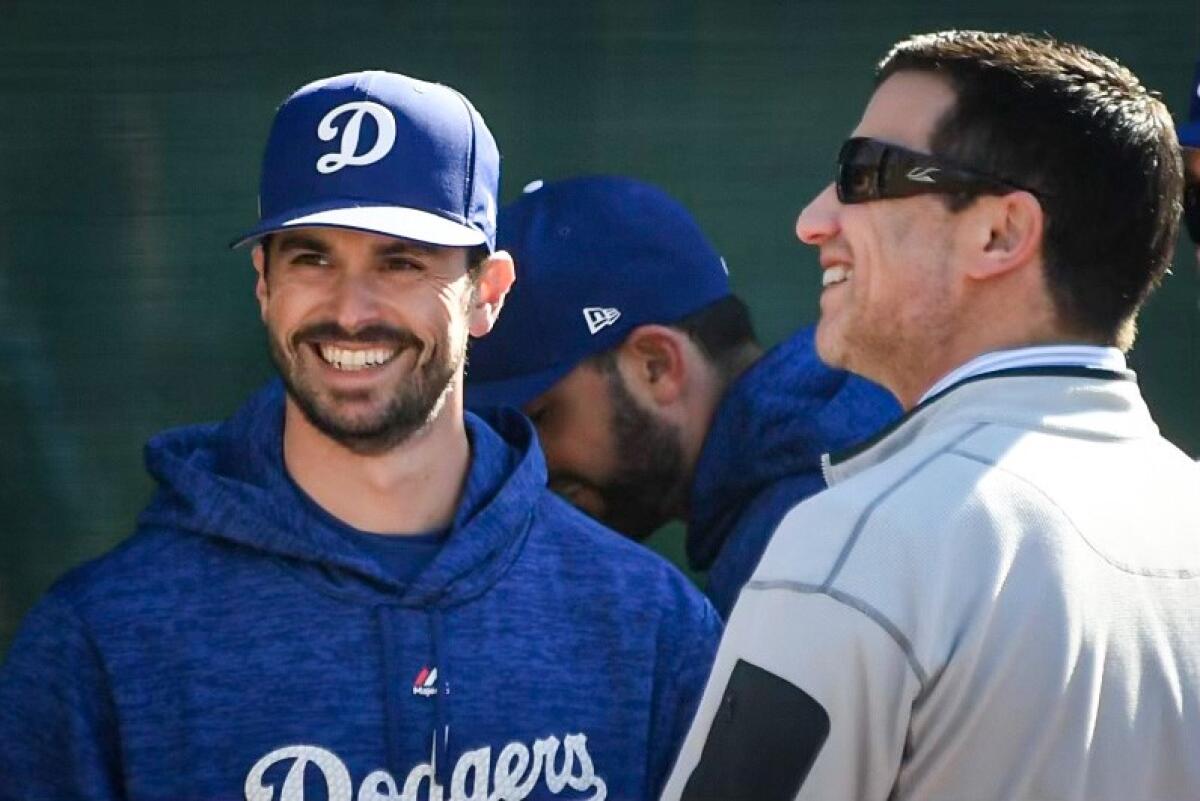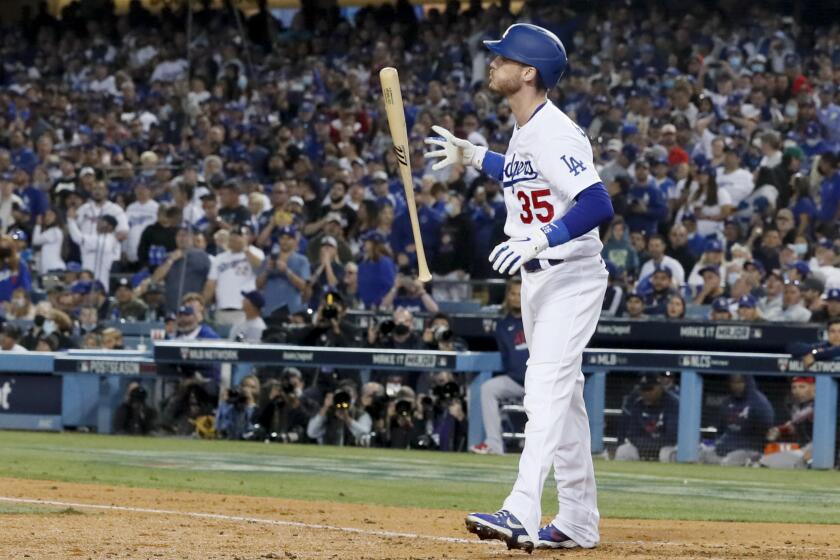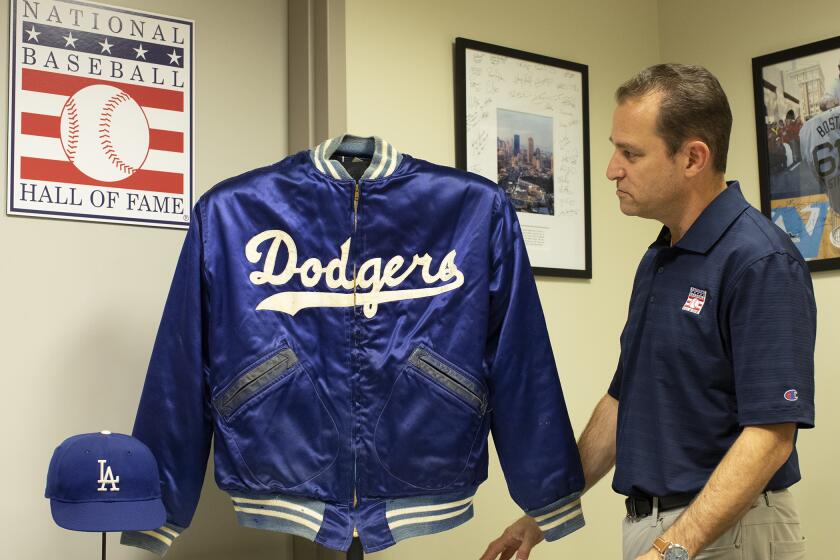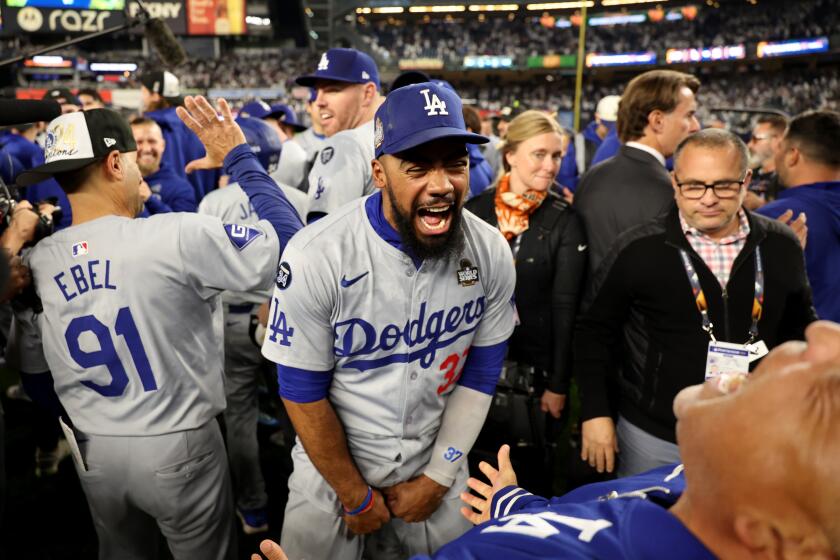Dodgers GM Brandon Gomes found his calling during his many stints in the minors

- Share via
You won’t find the most influential stat of Brandon Gomes’ playing career on the back of any baseball card.
During five major league seasons with the Tampa Bay Rays between 2011 and 2015, the right-handed reliever racked up 173 appearances, 144 strikeouts and a 4.20 ERA. He was part of two teams that reached the postseason. He once drew a bases-loaded walk as a hitter, the only time in his career he reached base.
But it was something else that propelled Gomes into his post-playing career as a front-office executive, a second act that reached new heights Tuesday when the Dodgers announced the 37-year-old had been promoted to general manager.
As a player, Gomes was sent down to the minor leagues on 12 occasions in his five years with the Rays. And every time it happened, it piqued his curiosity about baseball operations a little bit more.
“Just the nature of my career, I was very average,” Gomes said recently with a chuckle. “I would get sent down or see different moves happen, so it was always interesting to me how the mechanics of it all worked.”
Barely five years removed from his playing career, Gomes looks at those times as a starting point for his current path, in which he has become the first Dodgers general manager to serve under Andrew Friedman, the team’s president of baseball operations, since Farhan Zaidi was hired by the San Francisco Giants in 2018.
Former major league pitcher Brandon Gomes has climbed swiftly since joining the Dodgers’ front office in 2016. He was named general manager Tuesday.
Friedman ran the Rays’ front office during the first four seasons of Gomes’ major league career. He was the one who brought Gomes to Tampa Bay, acquiring the then-minor league prospect from the San Diego Padres in a 2010 trade for Jason Bartlett.
Gomes frequently came to Friedman with questions as the pitcher’s interest in front-office mechanics — and a desire to make himself as valuable as possible to stay in the majors — continued to grow.
“He sought us out in the front office and had a bunch of questions about how he could improve, and what we were seeing through our lens,” Friedman said. “I’ve been around a lot of other players that slot into that part of the roster and they haven’t necessarily had that, especially while playing.”
Friedman recalled one conversation when, after one of Gomes’ dozen demotions, the pitcher sought out Friedman and then-Rays vice president of baseball operations Erik Neander.
“He said, ‘Hey, I’d like to understand as much as I can about what you guys are seeing, and what levers I can pull to get better,’ ” Friedman said. “He just had a really impressive way of receiving constructive criticism and being so focused on what he could do to get better and to really understand.”
During his high school and college days, Gomes was never sure if a major league career, as a player or executive, was in his future.
The Fall River, Mass., native wasn’t drafted out of high school, despite a stellar two-way prep career in which he was named the state’s Gatorade Player of the Year as a senior.
As a college pitcher at Tulane (the same school Friedman graduated from in 1999, though the two didn’t connect until their time with the Rays), Gomes underwent Tommy John surgery as a sophomore and didn’t get drafted until he was a fifth-year senior, taken in the 17th round by the Padres in 2007.
Even then, Gomes, who double-majored in finance and business law, was preparing to apply for law school, mapping out a Plan B in case his professional baseball career was short-lived.
“I had everything teed up,” Gomes said. “I had letters of recommendation. I took my LSAT. I was like, whenever I get released, at least I’ll be prepared to go to law school and get my degree.”
Gomes then paused and laughed.
“Obviously,” he said, “that didn’t happen.”
Instead, Gomes rose through San Diego’s minor league system, bounced back and forth to the majors with Tampa Bay, and began acquiring the knowledge and skills that would help him after his retirement as a player.
“Throughout my career, there was just an interest overall in how things worked and general roster construction,” he said. “Obviously it’s not a major focus when you’re playing, but I always found it interesting and would ask questions whenever I was around our front-office group in Tampa.”

From his conversations with Friedman, Gomes began to understand how executives quantified value, developed players and built their organizations.
While rehabilitating an injury one year, he got close to the scouting department to see how they prepared for the upcoming draft.
And in 2015, Gomes committed himself to learning about pitch mechanics and analytics, ratcheting up his slider usage after seeing data that ranked it as one of the best in the majors.
As a result, he stayed on the Rays’ roster almost the entire season, throwing a career-high 59 innings and striking out a career-best 44 batters.
“It was interesting to see that this is how you can more efficiently use your arsenal and optimize those things,” Gomes said.
Despite his consistency in 2015, Gomes became a free agent the following offseason and signed a minor league contract with the Chicago Cubs. He never pitched in the majors again, struggling during the first half of 2016 in triple A before being released and retiring midway through the season.
He didn’t stay out of baseball for long.
That fall, Gomes reached out to Friedman, by then two years into his tenure heading up the Dodgers’ front office, inquiring about a job. Friedman immediately hired him to be a pitching coordinator, long ago sold on Gomes’ potential in baseball operations.
“He was someone that we wanted to be aggressive to figure out how to bring into the mix,” Friedman said.
After the 2017 season, when he worked with a class of pitching prospects headlined by future big leaguers Walker Buehler, Dustin May and Caleb Ferguson, Gomes was promoted to director of player development after Gabe Kapler was hired to be the Philadelphia Phillies manager.
Gomes’ new role heading up the farm system came with a new set of lessons, too.
You have been sending in lockout questions. Here are some answers.
“I remember being farm director, and being asked about whirlpools at Camelback Ranch,” he said. “I had no idea the scope of things that actually go on. There’s definitely a drinking-out-of-a-firehose component. But that was really good preparation.”
By 2019, Gomes was promoted again, this time to vice president and assistant general manager. In 2020, he was a key cog as the club won the World Series for the first time in 32 years.
This offseason, Gomes’ name surfaced as a candidate for the New York Mets’ open GM position. However, he said staying in L.A. was always his preference.
Now, he’s the fourth-youngest general manager in baseball.
“I think his ability to connect with people is something that really stands out,” Friedman said. “You couple that with the way his mind works and his passion for the game, and he’s had such an incredible impact on everything he’s touched. He’s moved pretty quickly, but you could argue that he could’ve moved even quicker.”
More to Read
Are you a true-blue fan?
Get our Dodgers Dugout newsletter for insights, news and much more.
You may occasionally receive promotional content from the Los Angeles Times.













